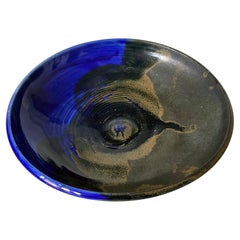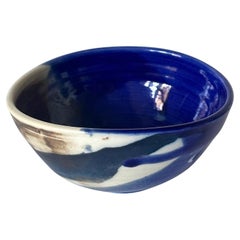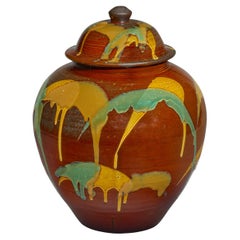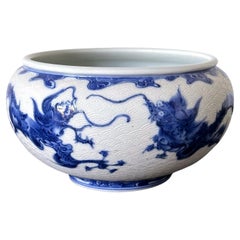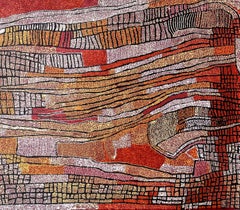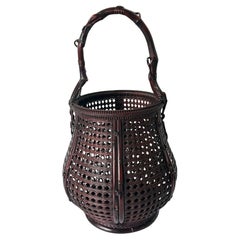TISHU
to
37
655
352
216
188
178
168
131
125
80
71
69
54
52
47
37
34
33
32
28
28
27
24
19
17
17
15
15
10
8
5
2
2
1
1
1
36
29
18
17
15
Large Ceramic Shallow Bowl with Brilliant Blue Glaze by Toshiko Takaezu
By Toshiko Takaezu
Located in Atlanta, GA
A glazed ceramic shallow bowl circa 1960s made by Japanese American artist Toshiko Takaezu (American, 1922 - 2011), whose work was heavily influenced by the Japanese ceramic traditio...
Category
Mid-20th Century American Modern Decorative Bowls
Materials
Ceramic
Ceramic Tea Bowl with Brilliant Blue Glaze by Toshiko Takaezu
By Toshiko Takaezu
Located in Atlanta, GA
A glazed ceramic tea bowl (chawan) circa 1960s made by Japanese American artist Toshiko Takaezu (American, 1922 - 2011), whose work was heavily influenced by the Japanese ceramic tra...
Category
Mid-20th Century American Modern Decorative Bowls
Materials
Ceramic
Japanese Ceramic Jar with Expressive Glaze Onda Yaki
By Onda Yaki
Located in Atlanta, GA
A Japanese lidded ceramic jar from the kiln of Onda Yaki, circa 2007. The stoneware jar impresses the viewer with a robust bulbous form. and exuberantly splashed and dripped glaze in...
Category
Early 2000s Japanese Organic Modern Ceramics
Materials
Ceramic
Japanese Glazed and Caved Ceramic Dragon Bowl by Makuzu Kozan
By Makuzu Kozan
Located in Atlanta, GA
A ceramic bowl by Japanese Imperial potter Makuzu Kozan (1842-1916) circa 1891 of late Meiji period. A very fine example of the artist's work that belongs to the middle period of his...
Category
Antique Late 19th Century Japanese Meiji Ceramics
Materials
Ceramic
Large Stunning Australian Aboriginal Painting by Naata Nungurrayi
By Naata Nungurrayi
Located in Atlanta, GA
A large and stunning contemporary abstract painting by celebrated Australian Aboriginal artist Naata Nungurrayi (1932-2021), stretched and ready for display. A rare masterpiece of the museum quality dating from the peak of the artist's creative output in 2003. The canvas is singular in both the impressive size and tine quality, and it comes with full provenance and step by step photos (100 in total) recording the creation of this significant piece of work.
The artist used fine dots as the sole element to compose a complex dreamtime landscape where Women's Ceremony took place in her ancestral time. The place is located at Marrapinti and its surrounds, where many water soakage holes were located. Dots in brilliant shifting and contrasting colors form ceremonial Tingari symbols performed by the women, black crawling tracks that may be associated with a site called Karilywarra (two carpet snakes) and mesmerizing Tali (sandhill) movements surrounding the canvas. The work is of the signature style of the artist, singular and easily recognizable. The fine quality of this work is exemplary.
Medium: acrylic on Belgium Linen
Cat no. NN200315
Provenance: Yanda Aboriginal Art, NT.
The painting comes with a COA letter and an artist biograph issued by Yanda Aboriginal Art and a presentation album with 100 photos that documented the entire process of the creation of this large work of art. The edge of the painting bears name of the artist as well as the stamp of the gallery as shown.
Reference and further reading:
For a relevant work by the artist, See Plate 88 and Page 220-222 in the book "Past and Present Together: Fifty Years of Papunya Tula Artists" by Meyers and Skerritt.
Another similar work is illustrated on plate 13 in "Pintupi" by Hamiltons.
Artist's biography:
Naata Nungurrayi (1932-2021) is an Australian Aboriginal artist who was born at the site of Kumil, west of the Pollock Hills in Western Australia. She is from the Pintupi group from Kintore, Northern Territory and is one of the senior elders of the Kintore women artist movement. Naata is the sister of George Tjungurrayi and Nancy Nungurrayi, and her son is Kenny Williams Tjampitjinpa...
Category
21st Century and Contemporary Australian Modern Paintings
Materials
Canvas
Japanese Woven Ikebana Bamboo Basket Maeda Chikubosai I
By Maeda Chikubosai
Located in Atlanta, GA
A woven bamboo ikebana hanakago (flower basket) with handle circa first half of the 20th century (Taisho or Showa era) by Japanese bamboo master Maeda Chikubosai I (1872-1950). In th...
Category
Early 20th Century Japanese Modern Vases
Materials
Bamboo
Japanese Woven Ikebana Bamboo Basket Maeda Chikubosai I
By Maeda Chikubosai
Located in Atlanta, GA
A tall woven bamboo ikebana hanakago (flower basket) circa first half of the 20th century (Taisho or Showa era) by Japanese bamboo master Maeda Chikubosai I (1872-1950). Hand-woven w...
Category
Early 20th Century Japanese Modern Vases
Materials
Bamboo
Japanese Woven Ikebana Bamboo Basket Ueda Shounsai Original Box
Located in Atlanta, GA
A bespoken Japanese hanakago (flower basket) for ikebana by Bamboo artist Ueda Shounsai (1897-1990). Hand-woven with bamboo and rattan, and equipped with a copper lined inner vase, the basket features a modern bucket form with bended bamboo frames. The body was woven with Thousand-line construction, also known as comb plaiting. It was designed in an oblique pattern that gives this piece a distinctive flavor. The arched handle was bended gracefully with branches attached to the rim of the basket. The base is inscribed Shounsai zo (尚雲齋造) to base. The basket comes with its original Japanese wood box...
Category
20th Century Japanese Modern Vases
Materials
Bamboo
Rare Japanese Woven Bamboo Basket Tanabe Chikuhosai Original Box
Located in Atlanta, GA
A rare woven bamboo basket by Tanabe Chikuhosai (1868-1945), the eldest brother of one of the most celebrated Japanese bamboo artist Tanabe Chikuunsai I (1876-1931), who developed a long lineage of the celebrated bamboo artists.
This beautifully woven hanakago ikebana basket has a classic Chinese vase form. It features a robust body with the double handles extended into a beautiful oval arch. Vigorously constructed with tight pine needle plaiting, the body was partitioned by tri-branched extensions from the handle. The middle branch extended further down along the body into a distinctive triangular shape. The same design was used for reinforcement front and back. The functional element blended seamlessly with the decorative motifs. the basket is a rare example of the work by the artist.
It was signed on the base Chikuhosai Made this (竹保齋造之) and it comes with the original signed Japanese wood box...
Category
Early 20th Century Japanese Modern Vases
Materials
Bamboo
Antique Swiss Jogl Tavern Center Table
Located in Atlanta, GA
A fabulous antique Swiss/German wood tavern table circa late 18th century, Known as Jogl table in Swiss Alps and German Bavarian region, the table features a skirt-boarded rectangula...
Category
Antique 18th Century Swiss Baroque Center Tables
Materials
Hardwood
Garra Hook Sculpture on Display Stand Mid-Sepik River Papua New Guinea
Located in Atlanta, GA
A Garra hook by Bahinemo People of Hustein Mountains from Mid-Sepik River region in Papua New Guinea. The highly sculptural mask is one of the most iconic and mysterious designs from...
Category
Mid-20th Century Papua New Guinean Tribal Abstract Sculptures
Materials
Wood
Deep Relief Steel Front Sideboard Cabinet PE-42 by Paul Evans
By Paul Evans
Located in Atlanta, GA
A large and stunning sculpted-front cabinet by Paul Evans (1931-1987), model PE-42, made in 1970 in his studio for Directional. The model was one of the largest case pieces made by P...
Category
Vintage 1970s American Mid-Century Modern Cabinets
Materials
Slate, Steel
Early Ceramic Vase with Unique Glaze Pattern by Brother Thomas Bezanson
By Brother Thomas Bezanson
Located in Atlanta, GA
An early ceramic vase in a pear shape form by celebrated potter Brother Thomas Bezanson (1929-2007). The shape of this porcelain glazed vase is one of the Chinese prototypes known as...
Category
Mid-20th Century American Modern Vases
Materials
Ceramic
Rare Antique Korean Bandaji Chest South Jolla Joseon Dynasty
Located in Atlanta, GA
A Korean Bandaji Chest circa 19th century (toward the end of Joseon Dynasty) from South Jolla (Cholla) province. Bandaji is known as drop-front half opening chest and was traditional...
Category
Antique 19th Century Korean Other Furniture
Materials
Iron
Korean Reticulated Celadon Brush Holder Joseon Dynasty
Located in Atlanta, GA
A Korean porcelain brush holder in hexagon form from the end of Joseon dynasty circa late 19th century. Cherished by the scholars, brushpot like this would grace the desk in the man'...
Category
Antique Late 19th Century Korean Other Ceramics
Materials
Ceramic
Sculptural Ceramic Handled Vase by Robert Turner
By Robert Turner
Located in Atlanta, GA
A black glazed stoneware free form vase with handle by American Ceramist Robert Chapman Turner (1913 - 2005) titled "Akan" and made in 1990. The vessel is one of the classic forms wi...
Category
1990s American Modern Vases
Materials
Ceramic
Gabon Punu Granary Door Panel on Custom Stand with Provenance
Located in Atlanta, GA
A wonderful Punu wooden door panel (one of the original pair) with the iconic carved female figure circa mid-20th century. These door panels were used for granary in Gabon. The door ...
Category
20th Century Gabonese Tribal Figurative Sculptures
Materials
Wood
Framed Stunning Chinese Qing Dynasty Kesi Peacock Third Rank Badge
Located in Atlanta, GA
A silk civil rank badge panel beautifully framed in a gilt Baux bamboo carved wood frame circa Qing dynasty mid-19th century. The square rank badge is known in Chinese as Buzi which ...
Category
Antique Mid-19th Century Chinese Qing Textiles
Materials
Silk
Pair Framed Superb Chinese Qing Dynasty Embroidered Peacock Third Rank Badge
Located in Atlanta, GA
A rare pair of finely embroidered silk civil rank badge panel framed in a black carved wood frame circa late Qing dynasty (mid-late 19th century). The square rank badge is known in C...
Category
Antique 19th Century Chinese Qing Textiles
Materials
Silk
Lwalwa Mother Figure Holding Baby DR Congo Africa with Provenance
Located in Atlanta, GA
A finely carved Lwalwa maternity figure holding a baby from Democratic Republic of Congo in Central Africa circa 20th century. The statue was acquired in 2006 from the collection of Jean-Pierre Hallet Collection of African Art.
The figure, with her robust body and a strong stand, wears a classic Lwalwa mask...
Category
Mid-20th Century Congolese Tribal Figurative Sculptures
Materials
Wood
Tall African Ibibio Head Mask with Polychrome Nigeria Provenance
Located in Atlanta, GA
A tall Ibibio wood mask from Nigeria, Africa, circa 20th century. The head mask was carved in with a frontal face with pierced eyes and a gapping mouth. On his head, a stylized hat ...
Category
20th Century Nigerian Tribal Figurative Sculptures
Materials
Rattan, Wood
Guere Mask from Cote d'Ivoire Africa with Sotheby's Sticker
Located in Atlanta, GA
A Guere wood mask with paint and fiber remnant from We people displayed on a metal stand. The We people (also known as the Krahn or Guere) are an indigenous African people that inhabit areas in nowadays eastern Liberia and western Côte d'Ivoire. Their material culture shares many aspects with the neighboring Dan tribe. Like the Dans, the We use a wide variety of masquerades, which hold important regulatory position within their small, egalitarian communities. Masks are owned by families and used by individual lineage members in contexts of social control, ritual ceremony and entertainment. This type of Guere mask, however, has a distinct fearsome character. The ferocious design with jagged facial expression, bulging tubular eyes are intended for use in mediations between community members, as visual aids during moral lessons, as well as forms of entertainment. By portraying the more frightening nature of the animal, the mask is viewed as powerful and may have been used as part of social control methods prior to the introduction of Western law systems during the colonial period.
The mask on offer, based on our examination, appears to be an original one that was used natively instead of reproduction made for the tourist market. The surface presents apparently genuine patina consistent with use. The red paint that highlights the eyes and gapping mouth also appear original. There are small losses flanking the nose ridge by the eyes, extensive surface accretion, remain of some fiber tassels. The back of the mask reveals chisel marks from hand tools and importantly, stain marks that were likely from repetitive contacts from the nose of the wearer.
The mask is 9" in height, and it retains an old Sotheby’s catalog...
Category
20th Century Ivorian Tribal Tribal Art
Materials
Wood
Helmet Crest Ngoin Mask from Cameroon Africa
Located in Atlanta, GA
This Helmet Crest mask is categorized as a “Babanki” style Ngoin mask from Northwestern provinces of Cameroon circa first half of 20th century. In part of highland area called “Camer...
Category
20th Century Cameroonian Tribal Tribal Art
Materials
Wood
Antique Japanese Ink Stone Maki-e Lacquer Box Suzuribako Edo Provenance
Located in Atlanta, GA
A Japanese ink stone box (known as Suzuribako) with exquisite maki-e decoration from Edo period (circa mid-18th century). The box features a rectang...
Category
Antique 18th Century Japanese Edo Lacquer
Materials
Wood, Lacquer
Antique Korean Table Top Chest with Drawers Joseon Dynasty
Located in Atlanta, GA
A small tabletop storage cabinet made from Paulownia wood and lacquered in black and decorated with yellow brass hardware circa 1900s of late Joseon dynasty. With two drawers for sto...
Category
Antique Early 1900s Korean Other Furniture
Materials
Wood
Lega Bwami Society Mask on Display Stand with Provenance
Located in Atlanta, GA
On offer is a Lega Bwami society wooden mask from the Democratic Republic of Congo. It was likely from the first half of the 20th century and an authentic in-field piece. The mask di...
Category
Mid-20th Century Congolese Tribal Tribal Art
Materials
Wood
Fine Antique Korean Bandaji Chest Gangwha Island Joseon Dynasty
Located in Atlanta, GA
A rare Korean Bandaji Chest circa late 19th century (toward the end of Joseon Dynasty) from Gangwha Island off the coast of Gyeonggi Do (close to Seoul). The island is located in the...
Category
Antique 19th Century Korean Other Furniture
Materials
Iron
Japanese Ceramic Seto Tea Leaf Tsubo Jar Edo Period
Located in Atlanta, GA
A Japanese glazed ceramic jar with a lacquered wood lid circa 19th century of late Edo to early Meiji Period. The stoneware tsubo was used as a storage vessel for produce such as tea...
Category
Antique 19th Century Japanese Edo Ceramics
Materials
Ceramic
Antique Korean Rice Storage Bin Dwiju Side Table
Located in Atlanta, GA
A square-form chest from Korea circa end of 19th to early 20th century (End of Joseon to Korean Empire period). The sturdy bin-like piece supported by unadorned block feet was made from solid elm (Zelkova) and pine wood. Traditionally, it was used in the kitchen to store rice or other grains (known as Dwiju in Korean). The simple minimalistic design was to meet its practical vernacular functionality. With time the piece has incurred tremendous characters and patina yet still retains a strong presence with an attractive aesthetic that is full of folky charm. This seemingly humble piece will make a great statement piece that shows off a wabi-sabi and earthy beauty in any modern interior.
The prototype of the rice chest...
Category
Early 20th Century Korean Other Furniture
Materials
Wood
Fine Japanese Satsuma Vase by Ryozan Okamoto for Yasuda Company Meiji Period
Located in Atlanta, GA
A finely decorated Japanese satsuma ceramic vase by Ryozan Okamoto (c.1820s-1910s) for Yasuda. Ryozan is the head artist working for Yasuda company, a Japanese ceramic makers and dea...
Category
Antique Early 1900s Japanese Meiji Ceramics
Materials
Ceramic
Chinese Scholar Rock Lingbi Stone on Display Stand
Located in Atlanta, GA
A tall Chinese scholar stone (also known as Gong Shi in Chinese; meditation stone and spirit rock in the West) of significant weight and volume is gracefully balanced on the wood dis...
Category
20th Century Chinese Qing Scholar's Objects
Materials
Stone
Fine Trumpet Satsuma Vase by Taizan Yohei
Located in Atlanta, GA
A tall ceramic satsuma ware vase in a rare slender trumpet form with very fine surface decoration by Japanese potter Taizan Yohei IX (1864-1922). The vase was dated to late Meiji period circa 1890-1900s.
The main motif and the focal point of the vase is the continuous panel that circumvents the entire mid-body, apparently a rendition of the Boy's Festival, known as "Tango no Sekku" in Japanese. The traditional festival is celebrated on May 5th of each year. Originated in Nara Period...
Category
Antique 1880s Japanese Meiji Ceramics
Materials
Ceramic
Large Japanese Porcelain Dragon Vase by Makuzu Kozan Meiji Period
By Makuzu Kozan
Located in Atlanta, GA
Made by the studio of the legendary Japanese imperial potter Makuzu Kozan (1842-1916), this is a large porcelain vase glazed in a soft yellow color with a subtle gradient, on top of ...
Category
Early 20th Century Japanese Meiji Ceramics
Materials
Ceramic
Ceramic Vase with Bespoken Glaze by Makoto Yabe
By Makoto Yabe
Located in Atlanta, GA
Made by Japanese ceramic artist Makoto Yabe (1947-2005), this stoneware vase features a globular body supported by a round pedestal foot. A similarly shaped neck extends to a rimmed mouth opening. Robust in form with thick wall, the vase is noted for its irregular cloved form. The surface is covered in a beige-yellow glaze, on top of which, dark brown strokes and thick white feldspar slip were artistically applied in a splashed and washed pattern. Together with some random shallow incision lines, they form an abstract painting with textured surface where some slip forms small droplets at the end of the stroke. The work was created in traditional Japanese manner and reflects the beauty of Wabi Sabi, a Zen aesthetic for the imperfect perfection.
The base was incised with the artist's cipher.
"Makoto Yabe's work beautifully exemplifies the transmission of Japanese ceramics to the West. Born in Fukushima, Japan, Yabe began studying ceramics in Kyoto at the age of nine. He completed his training at the age of 24, with a four-year apprenticeship under Jinmatsu Uno and Sango Uno. Yabe then came to Boston, where he was an integral member of the local ceramic community, yet he maintained his Japanese roots. As an instructor of ceramics, Yabe worked in the Boston area at numerous schools and universities, touching the lives of all his students and expanding their knowledge and appreciation of studio ceramics."
Biography sited from Pucker Gallery...
Category
Late 20th Century American Organic Modern Ceramics
Materials
Ceramic, Stoneware
Antique Large Korean Ceramic White Bowl Joseon Dynasty
Located in Atlanta, GA
A Korean ceramic porcelain bowl covered in a white glaze with a hint of bluish green circa 18th century, possibly earlier, of the Joseon Dynasty. The deep bowl is relatively large in...
Category
Antique 18th Century Korean Archaistic Ceramics
Materials
Ceramic
Antique Korean Ceramic White Bowl Joseon Dynasty
Located in Atlanta, GA
A Korean ceramic porcelain bowl covered in a white glaze with a hint of bluish green circa 18th century, possibly earlier, of the Joseon Dynasty. The deep bowl was hand-thrown on the...
Category
Antique 18th Century Korean Archaistic Ceramics
Materials
Ceramic
Small Korean White Ceramic Stem Bowl Joseon Dynasty
Located in Atlanta, GA
A ceramic stem bowl with high cylindrical pedestal foot in white glaze from Korea, circa 18 centuries of late Joseon Dynasty. By shape, this piece appears to be a ceremonial vessel t...
Category
Antique 18th Century Korean Archaistic Ceramics
Materials
Ceramic
"The Big Nude" Sumo Book with Stand Helmut Newton with Original Box
By TASCHEN, Helmut Newton
Located in Atlanta, GA
Helmut Newton's Sumo book. The first Sumo and also the most exciting and collectible one ever published by Taschen.
Signed and numbered to interior 'Helmut Newton'. This book is numb...
Category
1990s German Modern Books
Materials
Chrome
Editioned Photograph Jack Nicholson IV, London by Herb Ritts
By Herb Ritts
Located in Atlanta, GA
A framed black and white editioned photograph by American photographer Herb Ritts (1952–2002) dated to 1988. Entitled "Jack Nicholson IV, London", the work is one of the four iconic ...
Category
Vintage 1980s American Modern Photography
Materials
Glass, Wood, Paper
Rare Published Japanese Ceramic Bowl Makuzu Kozan with Original Inscribed Box
By Makuzu Kozan
Located in Atlanta, GA
A rare published glazed ceramic bowl with surface paint decoration by Japanese imperial potter Makuzu Kozan ((1842–1916) with its original inscribed tomobako storage wood box. Unlike the better-known works Kozan made for the expositions in the west and export to the foreign market, this piece exemplifies his work for the domestic market and specifically, the tea ceremony. The bowl was made in the so called "Utusushi" Ogata Kenzan (1663-1743), a celebrated Edo painter and ceramicist. Utusushi is loosely translated as "in the spirit of". It is not at all a simple imitation of a master, but a Japanese concept of embracing the spiritual essence of a master while the creator is free to mix in his or her own unique artistic interpretation and flavor.
The bowl was made to hold sweet cakes during the tea ceremony. It has a very distinguished form with a circular swelled lower body morphing into a square upper portion that further opening with flared rim. The surface has a distinct glaze pattern partitioned diagonally in black and brown. On top, snow-covered branches of prunus flowers were painted overglaze in a poetic near-abstract fashion. Blooming in winter, prunus flower is the symbol of the season and cherished for its resistance to cold. The bowl was likely reserved for the tea ceremony during the winter months.
A white porcelain plaque with Kozan in black inlay was placed on the black glaze toward the bottom. Under the base, the bowl was further branded with two incised characters "Makuzu" as shown. The original tomobako bears ink inscription and paper slip label "Sweet Bowl...
Category
Antique Early 1900s Japanese Meiji Ceramics
Materials
Ceramic
Korean Ceramic Celadon Turtle Form Water Dropper Goryeo Period
Located in Atlanta, GA
A Korean ceramic water dropper in the form of a turtle or tortoise from Goryeo Period circ 12-13th century. The realistically molded piece is covered in a mellow celadon glaze with s...
Category
Antique 15th Century and Earlier Korean Archaistic Ceramics
Materials
Ceramic
Korean Etched Glass Sculpture by Sang-Min Lee
Located in Atlanta, GA
Sang-Min Lee
Title: Black Glazed Bowl
Year: 2018
Engraved glass in artist's frame
Etched signature and year on the lower right corner
Provenance: Gallery Tableau, South Korea
Priva...
Category
2010s South Korean Modern Sculptures and Carvings
Materials
Glass
Korean Etched Glass Sculpture by Sang-Min Lee
Located in Atlanta, GA
Sang-Min Lee
Title: Celadon Cup
Year: 2018
engraved glass in artist's frame
Etched signature and year
Provenance: Gallery Tableau, South Korea
Private collection in US.
The piece i...
Category
2010s South Korean Modern Sculptures and Carvings
Materials
Glass
Contemporary Ceramic Sculpture Deconstructed Vase by Steven Young Lee
Located in Atlanta, GA
A bespoken ceramic sculpture made by American Korean artist Steven Young Lee (1975-) circa 2010s. Inspired by the antique blue and white porcelain jar from Joseon Dynasty, the piece ...
Category
2010s American Post-Modern Ceramics
Materials
Ceramic
Large Unusual Ceramic Pot with Rattle and Handprint by Toshiko Takaezu
By Toshiko Takaezu
Located in Atlanta, GA
A tall closed-form ceramic pot with rattle by Japanese American artist Toshiko Takaezu (American, 1922 - 2011) circa 1980-90s. The impressive stone vessel on offer is covered in a ba...
Category
Vintage 1980s American Modern Abstract Sculptures
Materials
Ceramic
Korean Ceramic White Porcelain Water Dropper Joseon Dynasty
Located in Atlanta, GA
A small Korean water dropper in rectangular form with beveled edges, circa early 19th century of the Joseon Dynasty. The milky white porcelain pie...
Category
Antique 19th Century Korean Other Ceramics
Materials
Ceramic
Large Korean Ceramic Jar Joseon Dynasty
Located in Atlanta, GA
A large Korean white porcelain jar with underglaze decoration circa late 19th century of Joseon Dynasty. The vase has a well-proportioned profile of a classic jar (known as Hangari in Korean and was being produced since 18th century from Punwon-ri Kilns) with a tall upright neck that extends to a generous opening and swelled rounded shoulder that tapers down toward the base. Many of these porcelain jars were decorated with underglaze cobalt blue painting...
Category
Antique 19th Century Korean Other Ceramics
Materials
Ceramic
Vintage Japanese Ceremonial Wedding Kimono with Embroidery Designs
Located in Atlanta, GA
A large Japanese Wedding Kimono with bold embroidery designs. The auspicious attire was known as Uchikake and was worn by the bride during the wedding ceremony made from silk and hea...
Category
Early 20th Century Japanese Japonisme Textiles
Materials
Brocade, Silk
Early Glass Sculpture Vessel from Tlingit Hat Series by Preston Singletary
Located in Atlanta, GA
A large early glass vessel in the form of a reversed traditional Tlingit Hat by American studio artist Preston Singletary (b. 1963) circa 1998. Base...
Category
1990s American Modern Abstract Sculptures
Materials
Art Glass, Blown Glass
Ceramic Tea Bowl with Brilliant Red Glaze by Toshiko Takaezu
By Toshiko Takaezu
Located in Atlanta, GA
A glazed ceramic tea bowl (chawan) by Japanese American artist Toshiko Takaezu (American, 1922 - 2011). The hand-built form shows slight irregularity and is covered with a brilliant ...
Category
1990s American Modern Decorative Bowls
Materials
Ceramic
Ceramic Tea Bowl with Mottled Yellow Glaze by Toshiko Takaezu
By Toshiko Takaezu
Located in Atlanta, GA
A glazed ceramic tea bowl (chawan) by Japanese American artist Toshiko Takaezu (American, 1922 - 2011). The hand-built bowl is covered with a striking matte glaze in mustard yellow w...
Category
Vintage 1980s American Modern Decorative Bowls
Materials
Ceramic
Black and White Photograph by Ralph Gibson Signed and Dated
By Ralph Gibson
Located in Atlanta, GA
A vintage gelatin silver photographic print by American photographer Ralph Gibson (1939-)
Untitled, the photograph depicts an antique stone female statue from the back showing the to...
Category
Vintage 1980s American Modern Photography
Materials
Paper
Chromogenic Photograph by Ralph Gibson Signed and Dated
By Ralph Gibson
Located in Atlanta, GA
A vintage chromogenic (C-type) photographic print by American photographer Ralph Gibson (1939-)
Untitled, the photograph depicts a wooden easel against a background of a pink wall. P...
Category
1990s American Modern Photography
Materials
Paper
Korean Celadon Ritual Incense Burner Joseon Dynasty
Located in Atlanta, GA
An antique Korean ritual incense burner circa 19th century (late Joseon dynasty). This type of porcelain incense burner was made in Bunwon Kiln in Gwangju, Gyeonggi Do, near Seoul. U...
Category
Antique 19th Century Korean Archaistic Ceramics
Materials
Ceramic
Fine Korean Box with Tray Iron with Silver Inlay Joseon Dynasty
Located in Atlanta, GA
A fine Korean iron box with intricate silver inlay dated to the late Joseon Dynasty circa 19th century. The body of the box is made from iron of a heavy weight although the wear on t...
Category
Antique 19th Century Korean Other Metalwork
Materials
Silver, Iron
Japanese Bronze Statue Nyoirin Kannon on Lotus Throne
Located in Atlanta, GA
A small and fine Japanese bronze statue of Nyoirin Kannon circa 18th century of Edo period. Kannon is bodhisattva of Mercy and Compassion (Avalo...
Category
Antique 18th Century Japanese Edo Sculptures and Carvings
Materials
Bronze
Fine Japanese Hibachi Lacquer with Inlays Meiji Period
Located in Atlanta, GA
A fine Japanese wood Hibachi with copper insert circa 1900-30s end of Meiji to Taisho Period. It can be used as a unique planter or to showcase a...
Category
Early 20th Century Japanese Meiji Lacquer
Materials
Copper
Antique Chinese Kesi Fourth Rank Badges Qing Dynasty
Located in Atlanta, GA
A fine silk kesi civil rank badge panel (known in Chinese as Buzi) framed and glazed. The fourth rank panel feature borders of fret archaic key and are cente...
Category
Antique 19th Century Chinese Qing Textiles
Materials
Silk, Giltwood
Framed Street Photograph by Vivian Maier Editioned with Provenance
By Vivian Maier
Located in Atlanta, GA
A framed black and white street photograph by Vivian Maier (American, 1926-2009), "Untitled, June 25, 1961". This is a gelatin silver print printed in 201...
Category
Vintage 1960s American Modern Photography
Materials
Wood, Paper
Framed Street Photograph by Vivian Maier Editioned with Provenance
By Vivian Maier
Located in Atlanta, GA
A framed black and white street photograph by Vivian Maier (American, 1926-2009), untitled and undated (circa 1950s), This is a gelatin silver print print...
Category
Vintage 1950s American Modern Photography
Materials
Wood, Paper
